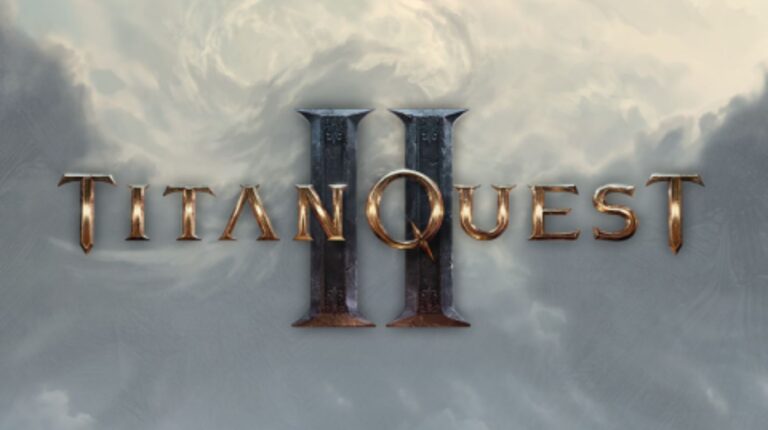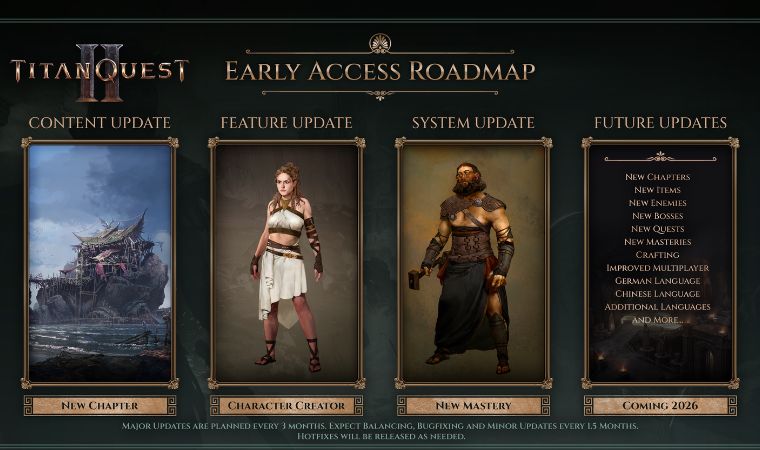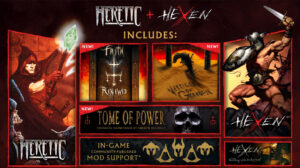Titan Quest II Charts Its Future With a Detailed Early Access Roadmap


Titan Quest II has emerged from the underworld of development with an Early Access launch that surprised many and impressed even more. Now, Grimlore Games has released a comprehensive roadmap that outlines exactly what players can expect as the game continues its long journey to full release. It is not guesswork. It is not vague promises. It is a map.
From new chapters and systems to refined multiplayer and character customization tools, the development team is laying out its vision with clarity. The Early Access period is expected to last until late 2026, meaning players who enter now are truly stepping in at the beginning of a multi-year odyssey.
“We aim to release major content updates roughly every three months. Smaller updates for fixes and balancing will be more frequent,” said lead developer, Balint Marczin. Addressing the more pressing interest of the full release date of the game, he said that it will depend on the pace of the early access development. “Right now, we are targeting late 2026. Our current goal is to deliver the updates in the best possible quality.”
And like any good mythological journey, it promises monsters, mysteries, and the occasional dead end. The difference here is that players will at least know where the road leads.
Jump to:
Grimlore’s Roadmap Reveals a Long Journey Through Myth and Combat
Grimlore Games has committed to a steady development cadence, with major content updates arriving roughly every three months. These updates will introduce fresh areas, new enemies, and new challenges that continue expanding the world of Titan Quest II. In between those milestones, players can expect smaller updates aimed at improving gameplay and resolving issues.
One of the highlights of the roadmap is the introduction of an all-new chapter – complete with its own environment, enemy types, and narrative beats. The addition of a new mastery will allow players to further diversify their builds, reinforcing the flexible dual-mastery system that is already central to Titan Quest II’s identity.
A fully-fledged character editor is also on the way, along with support for new languages, widening the gates for more heroes to step into this reimagined ancient world. Multiplayer, currently available in a preview state, is expected to receive full implementation over time—though anyone hoping to ride into battle on horseback will be disappointed. Mounts are officially not part of the vision.
A World Built on Secrets, Combat, and Community Feedback
The world of Titan Quest II is handcrafted with an emphasis on mystery, verticality, and mythological density. Players will explore picturesque coasts, haunted ruins, and even the realm of the Moirai themselves. Each location is designed not just to be traversed, but to be questioned. Every statue might tell a story. Every artifact might lead to something stranger still.
Enemies do not exist in isolation. They belong to factions, combine their abilities in combat, and require tactical awareness from players. Combat is action-heavy and built around timing, positioning, and ability synergy. Coupled with rituals that modify difficulty and loot systems that reward meaningful exploration, Titan Quest II invites replayability without needing to beg for it.

Community feedback is not just a talking point. The roadmap and recent developer video reflect direct responses to player concerns and questions. Grimlore Games appears to be actively adjusting its approach, building not only with mythology as its foundation, but also with its players shaping the walls.
Titan Quest II Offers Familiar Systems With a Sharper Edge
Those familiar with the original Titan Quest or other ARPGs like Diablo or Path of Exile will recognize the genre staples – masteries, loot progression, handcrafted worlds, and large-scale combat. However, Titan Quest II separates itself through its dual-mastery system, unique Greek mythology setting, and handcrafted approach to world design.
Unlike the procedural nature of many of its genre siblings, Titan Quest II doubles down on exploration and discovery. Every area feels deliberate. Every corner can contain a god, a monster, or a puzzle. It is less about grinding through maps and more about adventuring through epics.
Where other ARPGs offer fast-paced spectacle, Titan Quest II appears to favor a slower, more thoughtful progression rooted in lore. From rich audio design blending traditional Greek music with orchestral tones, to visuals that render myth in crisp, vertical layers, the game leans more toward storytelling than power-farming.


















